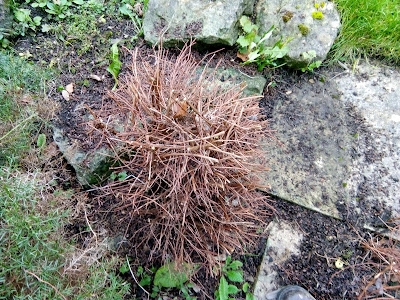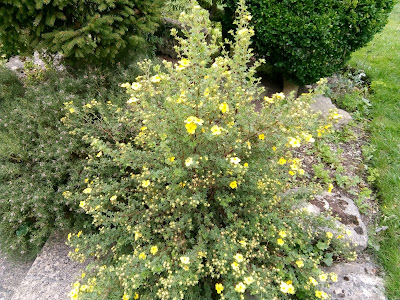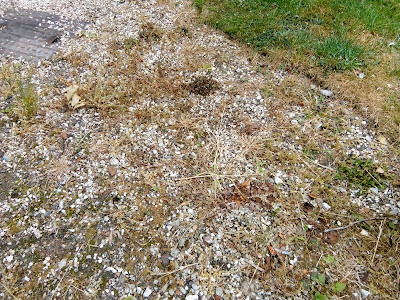Growing trees in pots is something we all do, from a decorative Acer to the odd seedling found in the garden and potted up "to see what it turns into", but it's about as cruel as it is possible to be. Why? For the following reasons:
1) Water
The
tree does not have access to water from the surrounding ground, it is
totally dependent on what we give it. Even if it rains, the surface area
of the pot is tiny, so it won't catch much - and a lot of the rain will
catch on the leaves and drip off, outside the rim of the pot anyway.
2) Water again.
The
water that we give the tree is usually tap water - it's chemically
treated, chlorinated, usually very cold, and lacks all the "dirt" that
you find in rainwater: minerals, organic material etc, If you think rainwater is "clean", just think about why we have window cleaners... or look in the bottom of your water butt, some time.
3) Nutrition.
We
may have given the tree top-quality shop-bought compost when it was first planted,
but after a few weeks, any nutrients in that compost will have been
exhausted, and the tree relies on us to replenish them. If we don't give
it a balanced feed every couple of months, it will struggle. Sorry, what was that? You didn't realise that shop-bought compost had a limited life? Yes - if you read the bag, it says "contains nutrients for up to 6 weeks". That's all! So if you have been growing this tree in the same pot for a year or two, it is not getting much in the way of nutrients!
4) Stale soil.
Without
any worms, beetles, grubs etc moving around within the soil inside the
pot, it becomes stale and compacted. Unfortunately, adding worms to the
pot makes it even worse: the worms will aerate the pot, yes: but by doing
so they will damage the roots. So it's not worth trying to "naturalise" the soil within the pot by shovelling in a handful of worms now and again.
5) Temperature shock.
Instead
of being tucked safely below the ground, the rootball of the tree is
unprotected, shielded only by a thin layer of terracotta or - worst of all -
plastic. This means the roots get baked by the hot sun, dehydrated by
the wind, and in winter, are subject to freezing and all the damage that
can cause.
And yet we still grow trees (and other plants) in pots.. *sigh*
Why do we do it? A major advantage of plants in pots is that you can move them around as
the fancy takes you - so if they are struggling, or looking unhappy, you
can move them somewhere more sheltered, or sunnier, or shadier, or just
somewhere different, until you find the place where they are happiest.
They can also be used seasonally: I have one Client who has a Norway Spruce in a biggish terracotta pot, and each November it gets moved in front of the French windows, so they can put outdoor lights and plastic decorations on it: there we go, a real Christmas tree without it dropping leaves everywhere, and without having to kill a tree every year.
But is there anything we can do, to make things better? Like it or not, sometimes having a tree in a pot is the only way to have the tree, and we wouldn't want a garden without trees, would we?
So what can you do to help your little trees in pots?
First and most obvious, put them in the biggest pot you can reasonably manage. A bigger pot holds more compost, and therefore more water: it doesn't dry out as quickly as a small one: there is more room for the roots to grow, and being heavier, it is less likely to fall over sideways on windy days.
Secondly, shape: there are two things to avoid here: curvy sided, narrow necked pots: and slender, narrow-bottomed pots.

Let's check out curvy pots first.
This pot, left, is a wonderful Ali-Baba shape: it's a very good size, it's beautiful to behold, but it's a bugger (technical term) when it comes to re-potting. This is because of the very narrow neck: you will find it impossible to get the plant out -
particularly if it is badly pot-bound.
Many is the time, over the years, that I have struggled, sweated and sworn at this particular pot, as the Fig within it grew, and was repotted.
So avoid bulbous pots with narrow necks, if you possibly can.
If you want curves, try to choose the less tight-necked shape: here are a nice collection of gently rounded pots with curved, but wide necks, on the steps at Cerney House, one of my favourite Cotswolds gardens to visit.
I think I like this arrangement in particular because it is symmetrical, which I always like: and the blue pots are very similar to the ones in my garden! (it's always nice when you see your own personal choice of style etc, in a "professional" garden!)
These ones do indeed have a narrower neck, but it is not much of a bottleneck, and they are quite straightforward, when it comes to re-potting time.
So my advice, as a professional, is to go for straight-sided pots, if you possibly can.
Another shape to avoid is the sort with a narrow bottom - but for a different reason.
This one - right - is beautifully stylish, but oh my goodness, how prone to tipping over is that going to be?
Plus, if you think about it, the roots of a tree will start from the central point, then spread outwards, much as the above-ground growth does.
So, in this pot, just as the roots are thinking about extending themselves, they meet the sides of the pot.
And the deeper they go, in desperation, the less soil there is!
This one, left, is better: it has nice straight sides, but it is proportionally tall-and-narrow, so it's already a bit top-heavy.
If it were twice as wide, but with the same taper, it would be absolutely fine: but this one is possibly likely to topple over, so it would be better used for low-growing plants, rather than for a tree.
Thirdly, moving on from shape, there are other issues with growing trees in pots, one of which is their propensity for sneaking roots out of the drainage holes and into the shingle or soil below.
I nearly lost one of my lovely potted Japanese Maples in that way: I did think it was getting a bit lush and vigorous, considering it was in a pot, and when I tried to rotate the pot, to encourage it to grow straight, I found it had rooted right through into the shingle, through the shingle, through the membrane, and into the soil below.
I had no option but to cut off the exploratory root, sob! sob! This gave the tree quite a set-back, although it did survive the experience.
Which lead on to a dual-function piece of advice: put your potted trees up on "feet". This not only prevents them sneakily rooting into the ground, but also allows better drainage, as large pots can suffer from being waterlogged, in winter, once their drainage holes block up.
(I say "once" the holes block up, not "if" the holes block up, because they invariably do...)
If you want your pots to be positioned in amongst your beds or borders, rather than sitting on a patio or a path, then rooting through the hole is going to be a very real problem, so
I'd suggest getting a small stone/concrete slab, like a stepping stone,
to put underneath the pot. If you have decorative mulch such as bark, on the bed, then just push the bark up all around the slab, and you will hardly see the slab at all, while still making sure that the plant can't root through into the ground.
Fourthly, group them together: one pot, all alone, suffers from too much drying wind, or hot sun, or freezing temperatures: but if you put a few of them together, they form a little micro-climate, and shelter each other. It also makes it easier for you to water them!!
Too much variety can look like pick'n'mix, or "jumble sale", so try to
group them in ways which please the eye: for instance, pots of the same
colour or style always look stylish together, such as this group, left:
Normally I find that odd numbers of pots looks more "natural", if that's not a funny word to use for hard, man-made pots.
So generally speaking, groups of three, five or seven pots look best, but in this case four looks fine, possibly because there are three pots with plants in (one is empty), there are three pots on the decking (one is raised)...
This collection, on the other hand - right - is too crowded and cluttered, with no theme, no cohesion regarding the planting, or the shapes, or the colours: and how do you get to the middle ones, to water them, check them, weed them?
I have a Client who has something pretty much like this, and it's a constant pain to maintain it. (Which is, of course, why they ask me to do it, instead of doing it themselves!)
Fifthly (still not sure if that is a real word), feed them. Make a point to give your potted plants a balanced feed
(something like Growmore, it doesn't matter if it is pellet or liquid) maybe once a month, through the growing season.
Oh, and once a year, give them a top-dressing: that's where you gently scrape off the top layer, and replace it with a layer of fresh compost, maybe with a mulch on top of that.
So that's a few points on how to keep your potted trees happy.
As for re-potting, this is not - strictly speaking - necessary, especially if you don't want the trees to get any bigger. It is good practice, horticulturally speaking, to re-pot them, maybe once every couple of years because it gives you a chance to check the roots, check for pests, see how they are getting on, etc, but you can simply de-pot them, check the roots, reduce the roots slightly, and put them back in the same pot, if you are happy with their current size.
I have Horse Chestnut trees which must be at least 12 years old, still less than 4' high in their relatively small pots. And they are staying in those pots, until I move house and get a bigger garden!!
Did you enjoy this article? Did you find it useful? Would you like me to answer your own, personal, gardening question? Become a Patron - just click here - and support me! Or use the Donate button for a one-off donation. If just 10% of my visitors gave me a pound a month, I'd be able to spend a lot more time answering all the questions!!









































